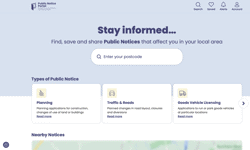The market place in Kent radically changed in April 2009, and remains one of the most competitive counties in the country for regional press with three major publishers. Kent Regional News and Media altered its strategy from the traditional paid and free titles to a new hybrid distribution method. This meant that the Kent Messenger Group, whilst firmly committed to quality paid-for newspapers, had to change and adapt its free newspaper letterbox operation in Kent.
The launch of the hybrids and a concurrent double digit increase in newsprint costs led to an urgent need to be smarter with every free newspaper printed. We urgently needed to review and rethink our free newspaper distribution strategy. No longer was going for every door, ie. the largest number in the market place, a viable method. Instead, strategy dictated the need to integrate various distribution models into a multi-faceted operation.
Firstly, it was back to basics. From now on, knowing where we delivered by title, round, postcode and door was not enough, we also needed to be able to visualise the distribution area as a whole. This entailed mapping the current delivery rounds to identify the letterbox area of each title on one map. As a result, it soon became apparent what an essential tool this simple one-off exercise proved to be. Previously, what had always been a virtually invisible letterbox distribution came to life allowing us to make quick, informed decisions and create the right mix of distribution methods for both advertisers and readers right down to door level.
The next stage involved using this mapping as a means to identify where letterbox copies could be removed and infilled, with either a pick-up point or a hand-out site. It was essential for commercial teams to be able to accurately define distribution areas to their advertisers. Equally as important, was the need to maintain a stable delivery network. There was a need for a shakeup and an innovative, divergent, new method had to be created. Wherever possible, whole postcodes were removed from the letterbox method of distribution and replaced with a more efficient pick up point operation, with some areas being supplemented by hand out sites. This enabled the same doormat access without the need to deliver en masse, thus stability of the delivery network and an accurately defined distribution area were maintained.
Staying ABC compliant
Another key element to this part of the strategy was that, whichever method replaced the letterbox copy would need to be an ABC compliant copy and count towards the Kent Messenger Group’s ABC figures. Self Select Distribution Ltd was able to meet these criteria and so was selected to provide such a service. With exclusive direct access to the major four supermarkets, petrol stations, Homebase and local Co-operative stores across the country, Kent Messenger Group were able to identify where to replace letterbox deliveries with pick-up copies. Within these outlets, the distributor has and maintains its own point of sale and display racks positioned either behind the tills as you exit or in the entrance foyer. This is to ensure that free pick-up copies are positioned well away from the news and magazine sections of the respective outlet in order to avoid confusion with any retail copies of the relevant paid-for title. This was vital, as confusion could lead to conflict with the paid-for titles and negatively impact long term sales and subsequent circulation figures.
So, how does our new distribution model work? Every week, there is an initial bulk drop of the relevant free titles to the chosen stores at consistent times. Each drop-off point is supported by relevant timed documentation and photographs to ensure that every copy placed is recorded. We get weekly reports detailing timings and quantities picked up, which is necessary to achieve ABC compliance. There is also a weekend top-up ensuring no empty points of sale. Standard caps are applied by ABC to pick-up points, set at a certain amount dependent on the outlet type. These caps can be increased by us using the reports we get from Self Select Distribution. The reports must show a consecutive eight week increase on total pick-ups for the specified outlet in order for the increased cap to be approved by ABC.
Higher visibility pleases advertisers
The feedback received via the Kent Messenger Group’s commercial team is that advertisers are very pleased to see the copies available for pick-up; for them, it is a much more visible form of distribution of the free newspaper. Moreover, those picking up the copy are opting in to it; that is to say they are actively seeking the newspaper and are therefore a definite reader of the free newspaper and a potential customer to the advertiser. When dealing with distribution queries, we have been able to point those readers that lost letterbox copies during the integration exercise to their local pick-up points, whilst also being able to advise when these become available. Initially, there was some apprehension amongst the editorial teams that a free title being made available in a retail outlet could damage the retail sale of the relevant paid-for title. However, it soon became apparent that this was not the case and our distribution model has been effective in defining the difference between actively purchasing a paid-for newspaper and its counterpart free pick-up title.
Brand-to-Hand
A third element was introduced into the distribution mix in February in order to complement letterbox and pick-up copies. This came in the form of Brand-to-Hand or handouts, which were positioned at strategic high footfall sites across Kent. These too had to be ABC compliant in order to count on official distribution figures. The key difference with these copies as opposed to pick-up ones is the fact it is a weekly net figure rather than an achieved capped figure. This net figure varies weekly as it is based upon the demand of that individual week (weather, season, holidays all effect demand) during the prescribed time in which the distributor hands out the free newspaper copies.
Following the success of the pick-up point method, it was decided we should further extend this type of distribution to some of our niche products. Formally, the paid-for newspaper would have been the vessel for carrying these supplements, however this would involve higher print runs than were necessarily required and involve high waste in the form of returns. Using Self Select Distribution and their route to the market place for these special publications, we were able to create our own miscellaneous network of relevant sites, tailored to each of the niche products. For example, the Arts & Events publications were delivered to tourist and visitor centres, cafes, bookshops as well as the traditional supermarkets that Self Select Distribution has exclusive access to, thereby creating a bespoke distribution list for each product.
To conclude, the use of pick-up points and Brand-to-Hand sites by the Kent Messenger Group has been successful, in replacing the more traditional letterbox copy of our free newspapers. It allows a reduction in print run without negatively impacting advertisers’ response or readership; indeed it enhances these, by making the product more visible in the market place. Overall, it has proved to be a much more efficient use of newsprint, time and resources.










